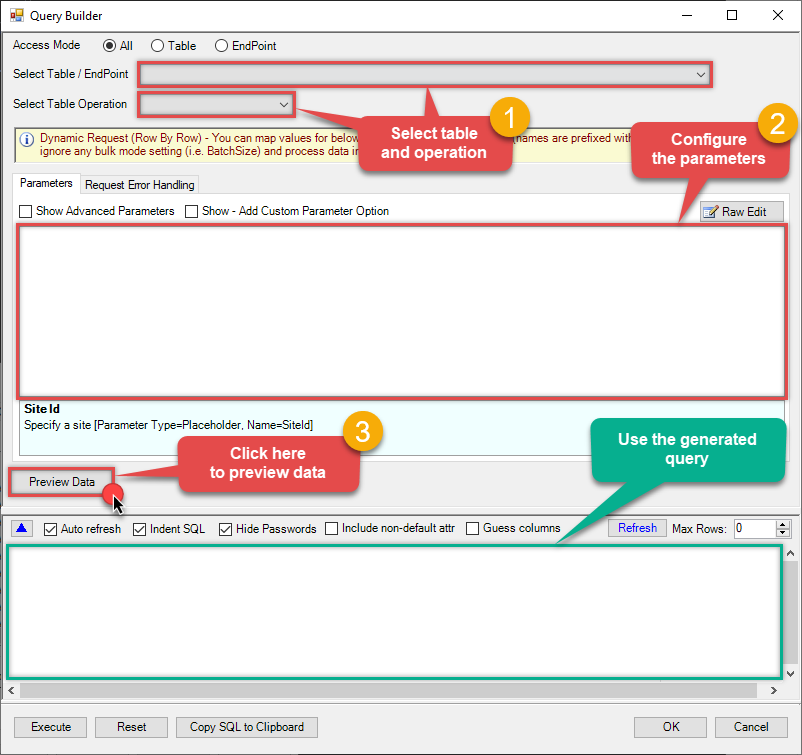Smartsheet Connector for UiPath How to Add Sheet Rows
Introduction
In this article we will delve deeper into Smartsheet and UiPath integration, and will learn how to add sheet rows. We are continuing from where we left off. By this time, you must have installed ODBC PowerPack, created ODBC Data Source, and configured authentication settings in your Smartsheet account .
So, let's not waste time and begin.
Use Query Builder to generate SQL query
-
The first thing you have to do is open Query Builder:
ZappySys API Driver - SmartsheetRead / write SmartSheet data inside your app, perform many SmartSheet operations such as Read, Insert, Update, Delete, List, Search, Export on objects like Sheets, Rows, Users etc without coding with easy to use high performance API ConnectorSmartsheetDSN
-
Then simply select the [Dynamic Table] table and Insert operation.
-
Continue by configuring the Required parameters. You can also set optional parameters too.
-
Move on by hitting Preview Data button to preview the results.
-
If you see the results you need, simply copy the generated query:
-
That's it! You can use this query in UiPath.
Let's not stop here and explore SQL query examples, including how to use them in Stored Procedures and Views (virtual tables) in the next steps.
SQL query examples
Use these SQL queries in your UiPath data source:
How to Create a new sheet row
This example shows how to create a new Sheet Row by calling INSERT statement. Optionally specify location where you like to insert new row (default is at bottom).
INSERT INTO [My Sheet]
( [Some Text Number Column], [Some Checkbox Column], [Some Contact List Column], [Some Date Column], [Some PickList Column], [Some Multi PickList Column], [Some Symbol Column] )
VALUES
('Updated at <<FUN_NOW>>', true, 'something@abc.com', '2024-12-31','Not Started','Value2,Value4','Green,Yellow')
/*
WITH(
RowLocation='"toTop": true' --insert at the top
--OR--
--RowLocation='"siblingId": 1231234567' --insert after some sibling row id
)
*/How to Bulk INSERT to SmartSheet from External System (e.g. ODBC Source / Microsoft SQL Server / OLEDB)
This example shows how to bulk insert into SmartSheet from any system such as Microsoft SQL Server or ODBC Source or OLEDB Source. Column names must match with Target Sheet column names in SQL Column alias.
INSERT INTO [My Sheet]
SOURCE( 'MSSQL'--OR 'ODBC'--OR 'OLEDB'
, 'Data Source=localhost;Initial Catalog=tempdb;Integrated Security=true'
--OR for ODBC
--,'DSN=MyOdbcDsn'
--OR (DSN less connection)
--,'Driver={Some ODBC Driver};uid=xxx;pwd=xxx;prop1=xxx;prop2=xxx....'
, 'SELECT ''2012-12-31'' [Some Date Column],''true'' [Some CheckBox Column],''Good example'' [Some Text Column]
UNION
SELECT ''2012-13-31'' [Some Date Column],''false'' [Some CheckBox Column],''Bad date example'' [Some Text Column]
UNION
SELECT ''2012-10-01'' [Some Date Column],''true'' [Some CheckBox Column],''Good example'' [Some Text Column]
')
--WITH(AllowPartialSuccess='true',output=1)
add_sheet_rows endpoint belongs to
[Dynamic Table]
table(s), and can therefore be used via those table(s).
Stored Procedures and Views
Create Custom Stored Procedure
You can create procedures to encapsulate custom logic and then only pass handful parameters rather than long SQL to execute your API call.
Steps to create Custom Stored Procedure in ZappySys Driver. You can insert Placeholders anywhere inside Procedure Body. Read more about placeholders here
-
Go to Custom Objects Tab and Click on Add button and Select Add Procedure:
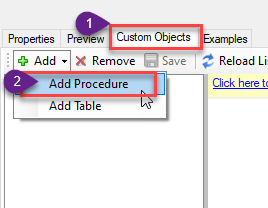
-
Enter the desired Procedure name and click on OK:

-
Select the created Stored Procedure and write the your desired stored procedure and Save it and it will create the custom stored procedure in the ZappySys Driver:
Here is an example stored procedure for ZappySys Driver. You can insert Placeholders anywhere inside Procedure Body. Read more about placeholders here
CREATE PROCEDURE [usp_get_orders] @fromdate = '<<yyyy-MM-dd,FUN_TODAY>>' AS SELECT * FROM Orders where OrderDate >= '<@fromdate>';
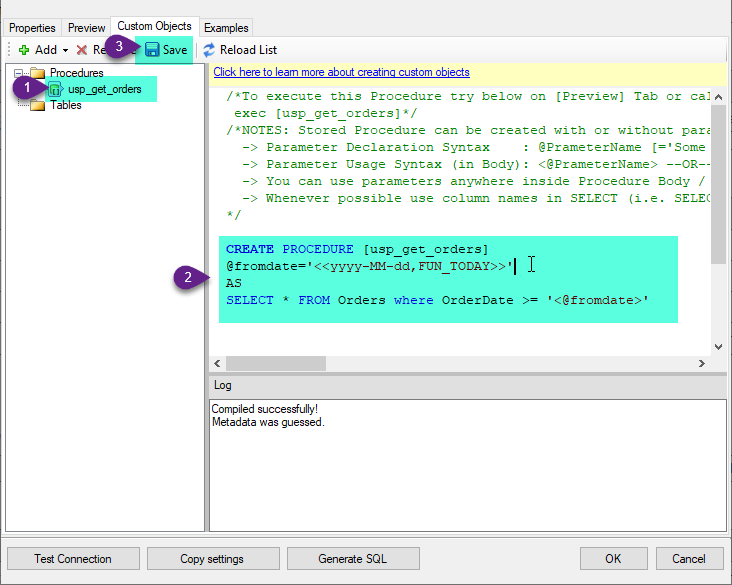
-
That's it now go to Preview Tab and Execute your Stored Procedure using Exec Command. In this example it will extract the orders from the date 1996-01-01:
Exec usp_get_orders '1996-01-01';
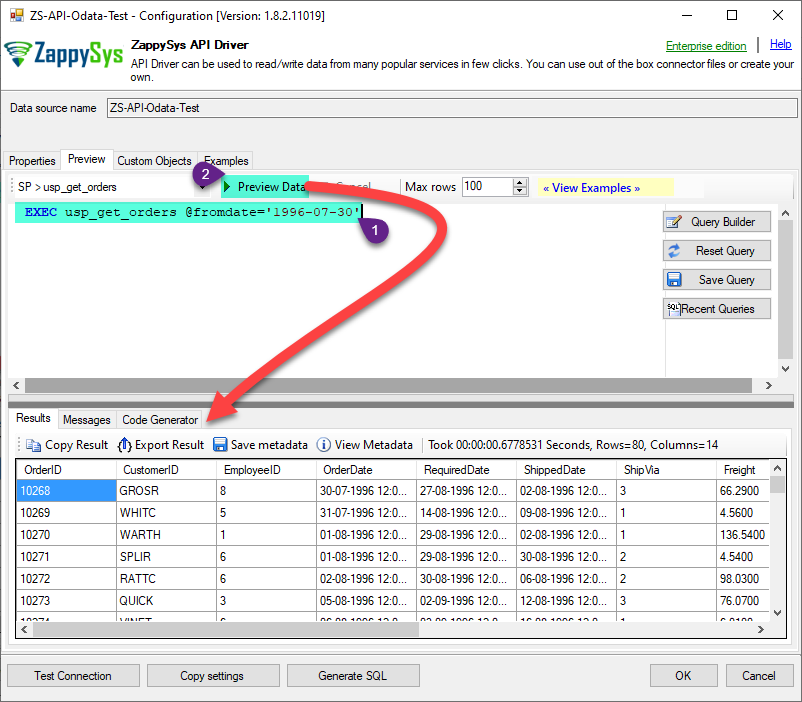
-
Let's generate the SQL Server Query Code to make the API call using stored procedure. Go to Code Generator Tab, select language as SQL Server and click on Generate button the generate the code.
As we already created the linked server for this Data Source, in that you just need to copy the Select Query and need to use the linked server name which we have apply on the place of [MY_API_SERVICE] placeholder.
SELECT * FROM OPENQUERY([LS_TO_SMARTSHEET_IN_GATEWAY], 'EXEC usp_get_orders @fromdate=''1996-07-30''')
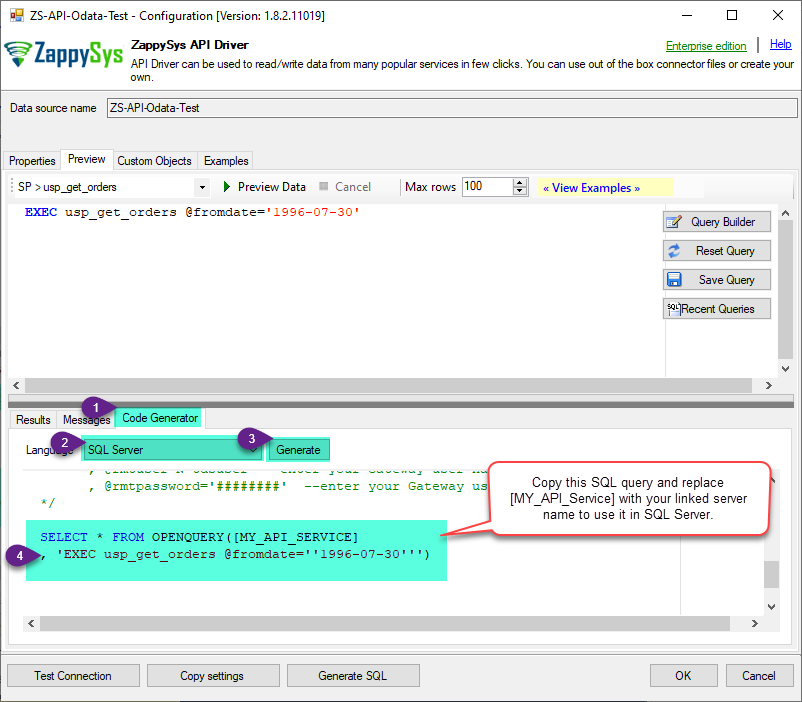
-
Now go to SQL served and execute that query and it will make the API call using stored procedure and provide you the response.
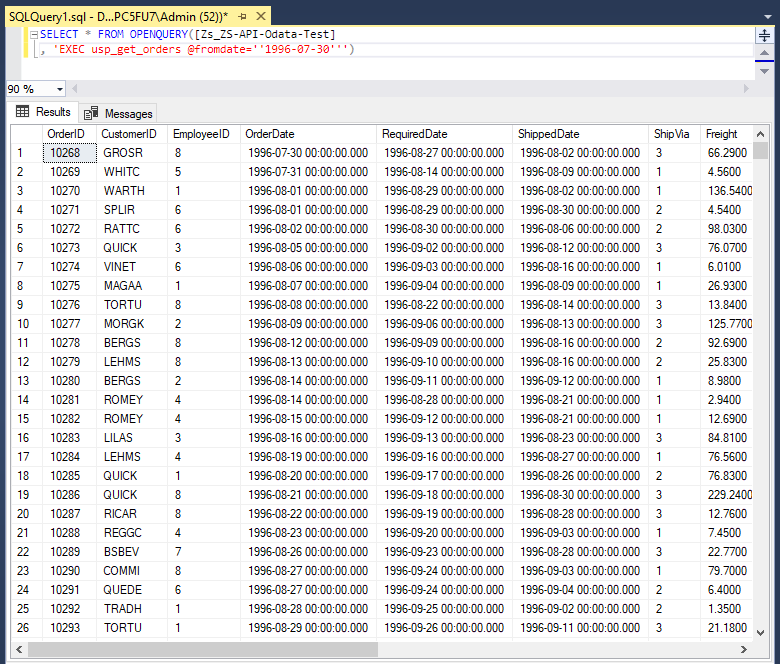
Create Custom Virtual Table
ZappySys API Drivers support flexible Query language so you can override Default Properties you configured on Data Source such as URL, Body. This way you don't have to create multiple Data Sources if you like to read data from multiple EndPoints. However not every application support supplying custom SQL to driver so you can only select Table from list returned from driver.
If you're dealing with Microsoft Access and need to import data from an SQL query, it's important to note that Access doesn't allow direct import of SQL queries. Instead, you can create custom objects (Virtual Tables) to handle the import process.
Many applications like MS Access, Informatica Designer wont give you option to specify custom SQL when you import Objects. In such case Virtual Table is very useful. You can create many Virtual Tables on the same Data Source (e.g. If you have 50 URLs with slight variations you can create virtual tables with just URL as Parameter setting.
-
Go to Custom Objects Tab and Click on Add button and Select Add Table:
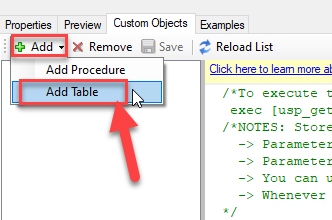
-
Enter the desired Table name and click on OK:
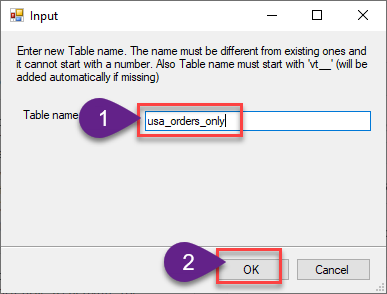
-
And it will open the New Query Window Click on Cancel to close that window and go to Custom Objects Tab.
-
Select the created table, Select Text Type AS SQL and write the your desired SQL Query and Save it and it will create the custom table in the ZappySys Driver:
Here is an example SQL query for ZappySys Driver. You can insert Placeholders also. Read more about placeholders here
SELECT "ShipCountry", "OrderID", "CustomerID", "EmployeeID", "OrderDate", "RequiredDate", "ShippedDate", "ShipVia", "Freight", "ShipName", "ShipAddress", "ShipCity", "ShipRegion", "ShipPostalCode" FROM "Orders" Where "ShipCountry"='USA'
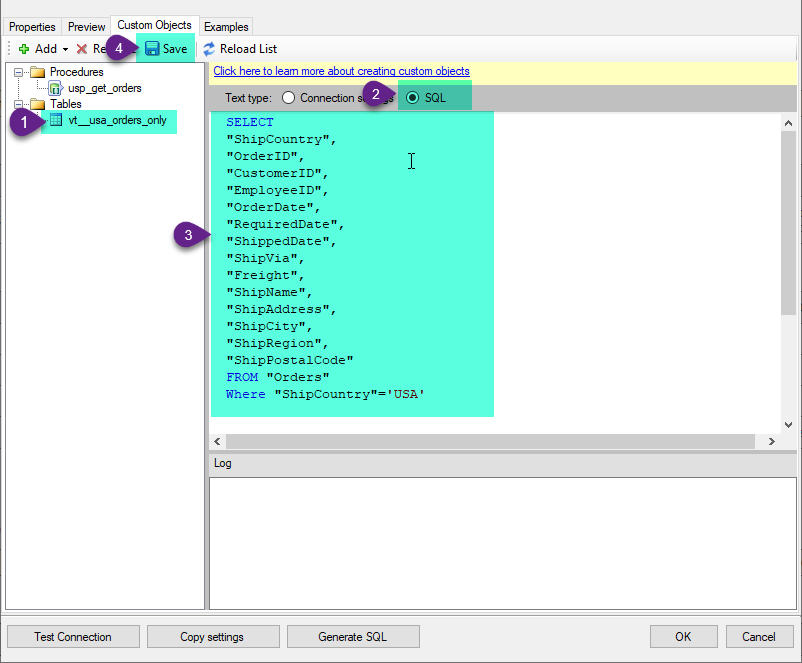
-
That's it now go to Preview Tab and Execute your custom virtual table query. In this example it will extract the orders for the USA Shipping Country only:
SELECT * FROM "vt__usa_orders_only"
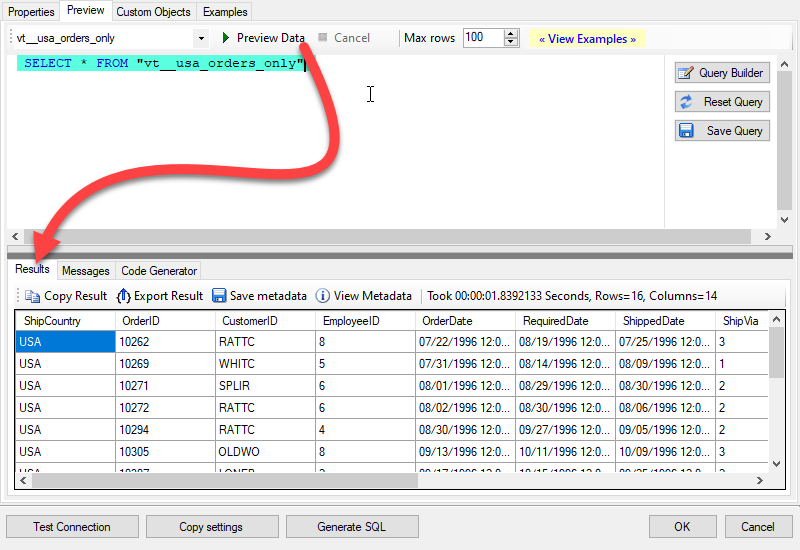
-
Let's generate the SQL Server Query Code to make the API call using stored procedure. Go to Code Generator Tab, select language as SQL Server and click on Generate button the generate the code.
As we already created the linked server for this Data Source, in that you just need to copy the Select Query and need to use the linked server name which we have apply on the place of [MY_API_SERVICE] placeholder.
SELECT * FROM OPENQUERY([LS_TO_SMARTSHEET_IN_GATEWAY], 'EXEC [usp_get_orders] ''1996-01-01''')
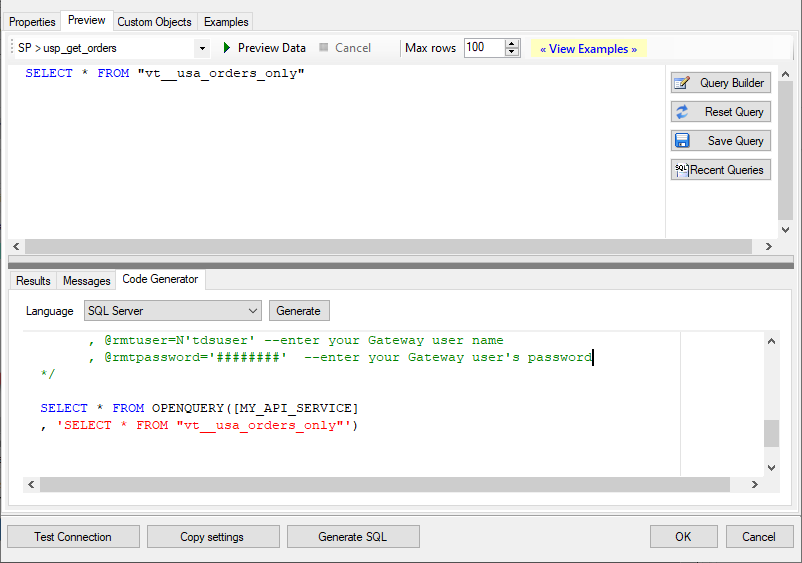
-
Now go to SQL served and execute that query and it will make the API call using stored procedure and provide you the response.
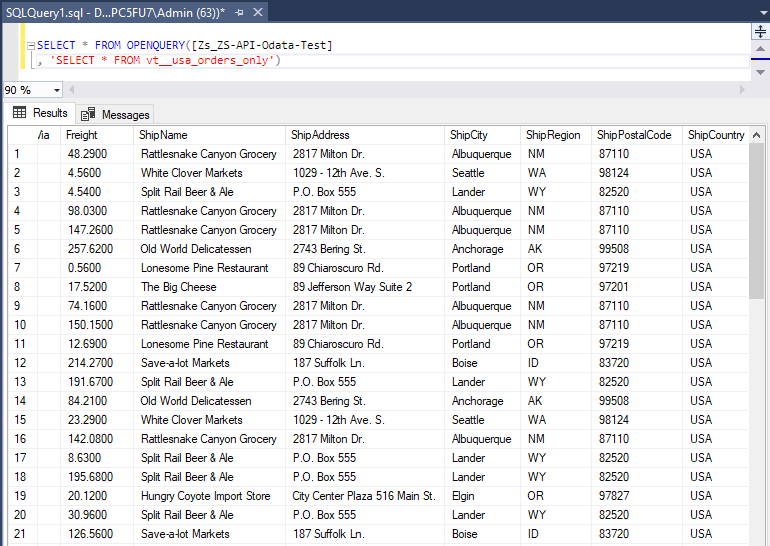
Add Sheet Rows in UiPath
- Open UiPath Studio.
- Before we really begin the work, make sure UiPath Studio is set as your profile (blue application icon).
-
In case, it is set to UiPath StudioX, you can change it in UiPath StudioX Settings:
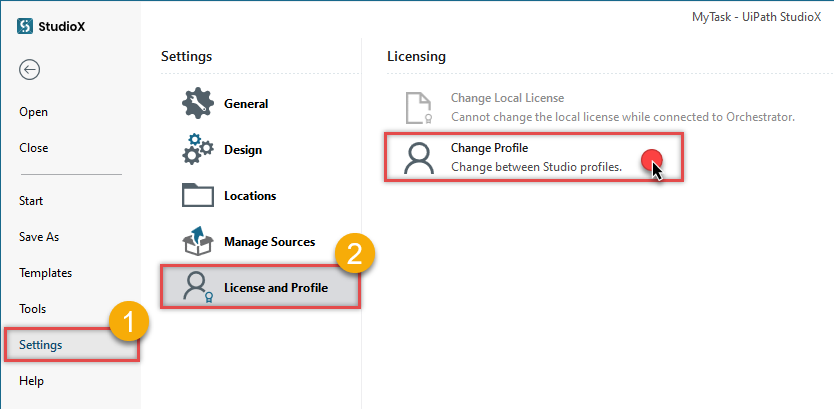 Simply select UiPath Studio option:
Simply select UiPath Studio option:
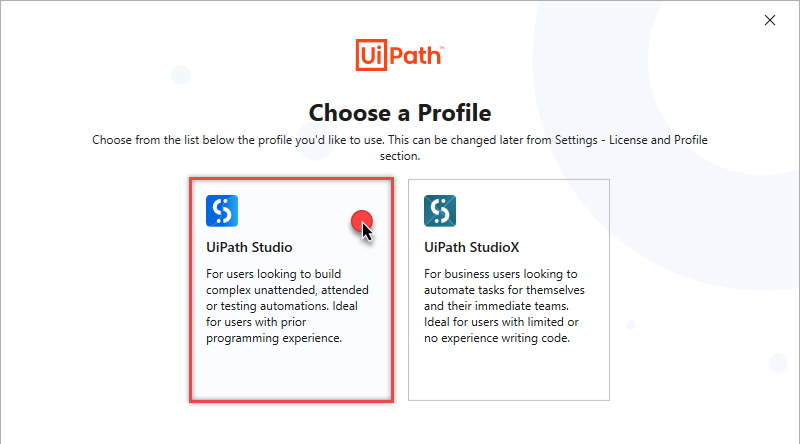
-
Start by creating a new project based on UiPath Process template:
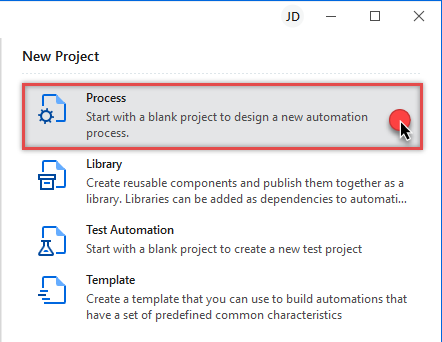
-
Add Run Query activity in Main Sequence box:
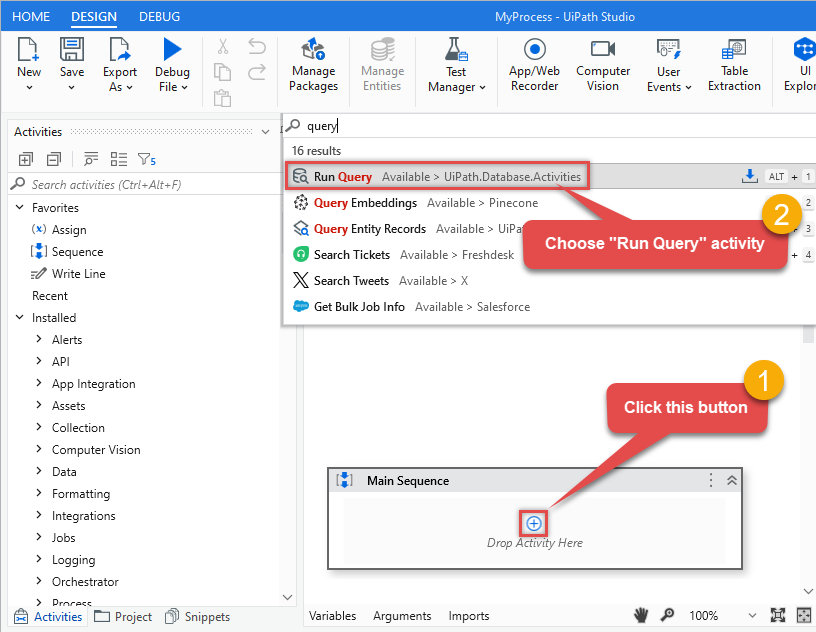
-
Click Configure Connection... button to create an ODBC connection:
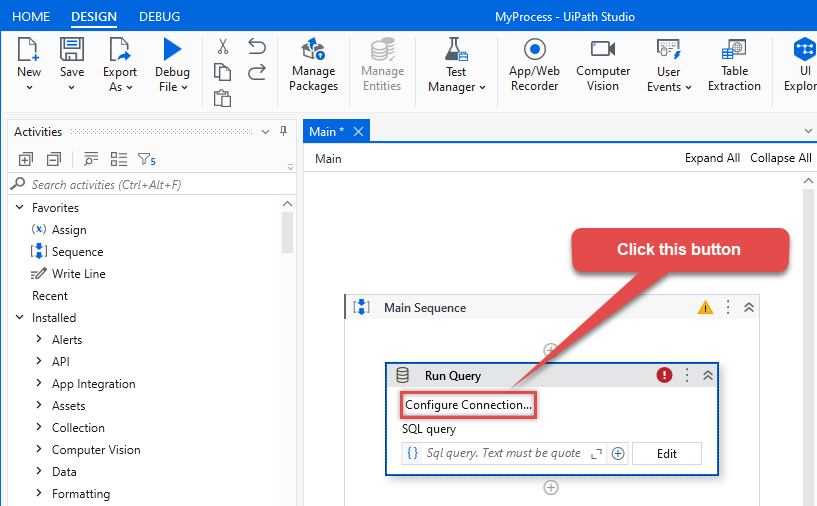
-
Continue by clicking Connection Wizard:
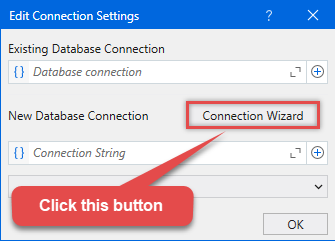
-
When the window opens, select ODBC-based driver, provider, and then choose ODBC data source:
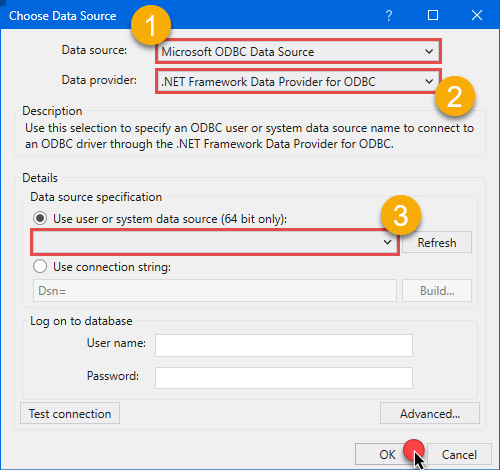 You can also select Use connection string option and use whole ODBC connection string instead. Obtain the connection string by pressing Copy Settings button in your data source configuration.
You can also select Use connection string option and use whole ODBC connection string instead. Obtain the connection string by pressing Copy Settings button in your data source configuration. -
Once you do that, it's time to configure a SQL query:
 Make sure, you enclose the query in double quotes!
Make sure, you enclose the query in double quotes! -
Proceed by adding a Write CSV activity after Run Query:
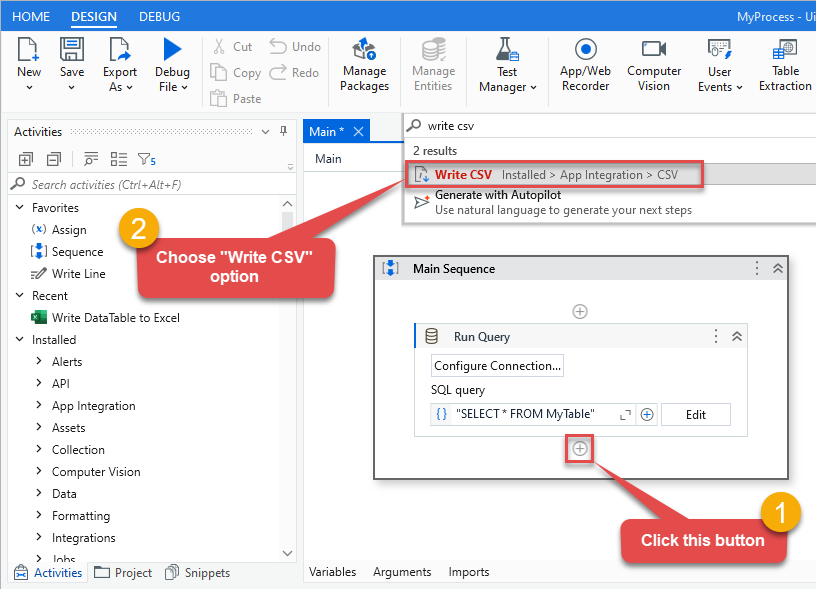 In this article we are using Write CSV, but you can freely add any other destination of your choice, e.g. Write DataTable to Excel.
In this article we are using Write CSV, but you can freely add any other destination of your choice, e.g. Write DataTable to Excel. -
Once you do that, configure the added Write CSV, this will write Smartsheet data to a CSV file:
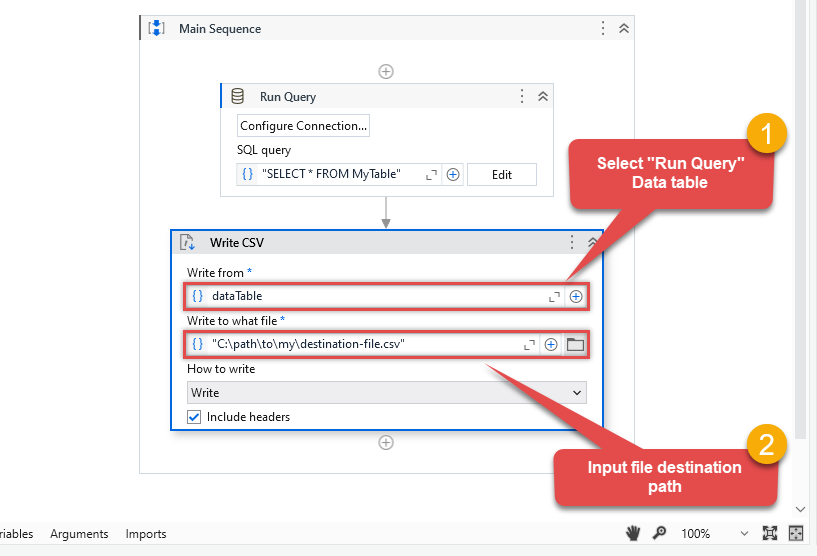
-
It's time for fun! Which means it's time for debugging! Just run the package locally to debug:

-
Finally, ensure there are no execution errors!

More actions supported by Smartsheet Connector
Learn how to perform other actions directly in UiPath with these how-to guides:
- Delete Sheet Rows
- Export Report (to PDF, Excel, CSV file)
- Export Sheet (to PDF, Excel, CSV file)
- Get Contacts
- Get Sheet Fields
- Get Sheet Row by ID(s)
- Get Sheet Rows
- List Contacts
- List Groups
- List Reports
- List Sheets
- Search (cell data or other object types)
- Send Report Via Email Excel Pdf Or Pdf Gantt Format
- Send Sheet Via Email Excel Pdf Or Pdf Gantt Format
- Update Sheet Rows
- Make Generic API Request
- Make Generic API Request (Bulk Write)

